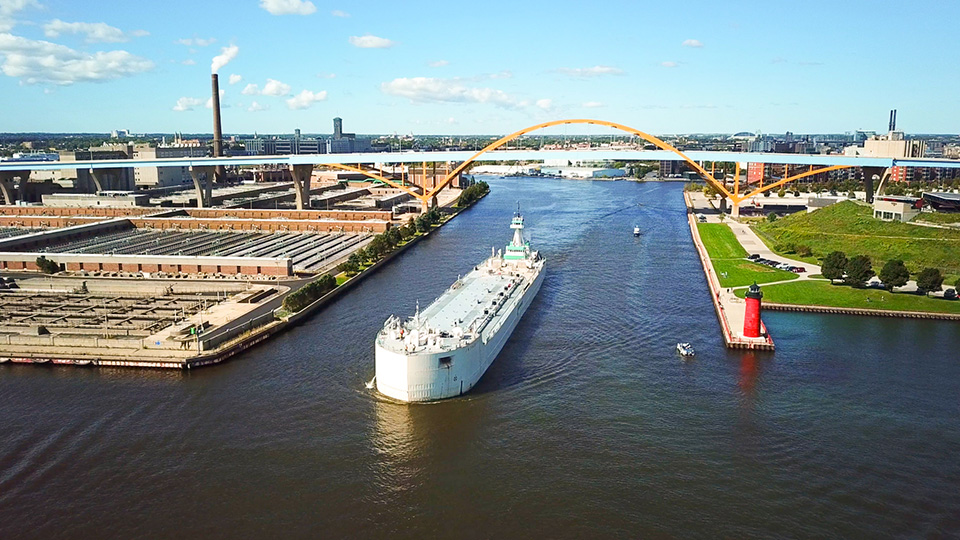
Hoan Bridge by the Port of Milwaukee (Photo: Port of Milwaukee)
Grant spurs soy infrastructure growth
November 16, 2023 | Bethany Baratta
Announced grant funding secured by DeLong Co., Inc., will present additional opportunities for shipping soy products from Port Milwaukee to global customers.
The $9.2 million grant will help DeLong Co., Inc., move into the second phase of their agricultural maritime export facility, located at Port Milwaukee, near Milwaukee, Wisconsin.
Phase I of the facility opened on July 18, 2023, and has primarily been used to export DDGs to international markets via the Great Lakes/St. Lawrence Seaway. Phase II of the project will involve the construction of two grain storage silos, electrical service upgrades, and additional handling equipment. The project will improve efficiency by expanding grain storage capacity for staging inbound and outbound grains by over 1.3 million bushels, according to DeLong. The grain handling equipment will also expedite the movement of grains and the new facility will allow the port to handle two commodities simultaneously. In addition, soybean meal exports are a potential area of growth in the future.
Prior to the announced grant award, the Soy Transportation Coalition (STC) approved $200,000 to help underwrite engineering, permitting, project management, and construction support expenses associated with Phase II of the project. Once the $200,000 was approved by the STC board, the commitment was conveyed to the U.S. Maritime Administration while the grant consideration window was still open.
“It was a compelling argument that the $200,000 provided by the STC would result in $200,000 less that the U.S. Maritime Administration would need to provide for the grant,” says STC Executive Director Mike Steenhoek.
There were three motivations for the Soy Transportation Coalition to provide funding for this project, according to Steenhoek:
- To provide meaningful investment to a project that will enhance U.S. soybean and soy product exports in the near future;
- To invest in the Great Lakes/St. Lawrence Seaway – a supply chain option that can and should be a more significant conduit to the global marketplace; and
- For the DeLong Company and Port Milwaukee to be able to highlight the funding commitment from a farmer organization, which would enhance the viability and competitiveness of their grant application.
“Soybean farmers have a long history of seeing their funding leveraged – thereby helping accelerate project completion and increasing its scale and scope,” Steenhoek says. “The investment by soybean farmers for DeLong’s Agriculture Maritime Export Facility is another tangible example of this.”
The U.S. Maritime administration announced DeLong as a recipient of their Port Infrastructure Grant Program on Nov. 3.
The announced award is well-timed, Steenhoek says.
“During this time in which U.S. agriculture has a number of supply chain challenges (low water on the Mississippi River, drought conditions at the Panama Canal, for example), it is imperative to have other supply chain options be available for farmers,” says Steenhoek. “While the Great Lakes/St. Lawrence Seaway accommodates a modest share of U.S. soybean exports compared to other regions of the country, it has the potential to play a more significant role in connecting soybean farmers with the rest of the world. The investment in the Agriculture Maritime Export Facility will certainly facilitate this.”
Working with DeLong and Port Milwaukee shows how the collaboration with others can grow opportunities for U.S. soy, Steenhoek says.
“Soybean farmers greatly appreciate DeLong and Port Milwaukee for the significant investment they are making to expand U.S. soybean and soy product exports,” Steenhoek says. “They are ultimately the ones making this investment happen. It’s been a pleasure to collaborate with them on this important project.”
Established in 2007, the
Soy Transportation Coalition is comprised of 13 state soybean boards (including the Iowa Soybean Association), the American Soybean Association, and the United Soybean Board. The goal of the organization is to position the soybean industry to benefit from a transportation system that delivers cost effective, reliable, and competitive service.
Back